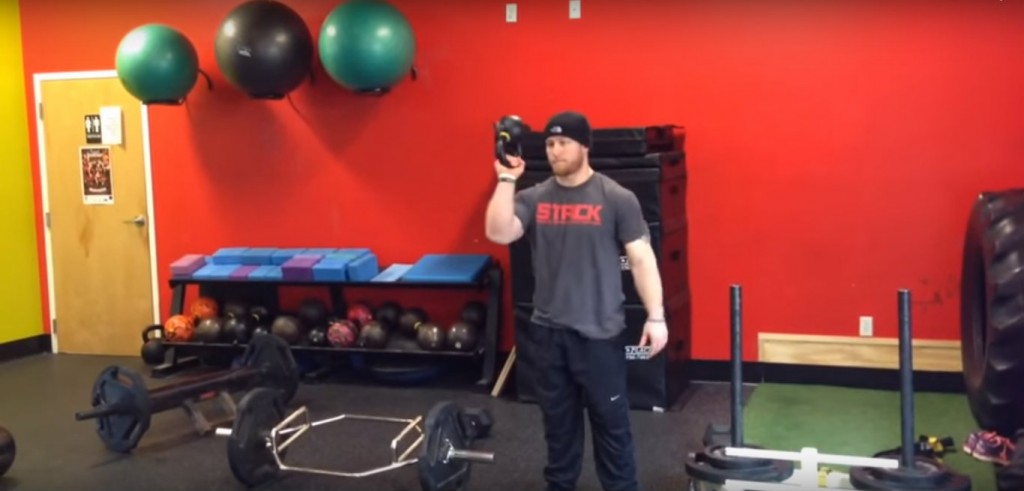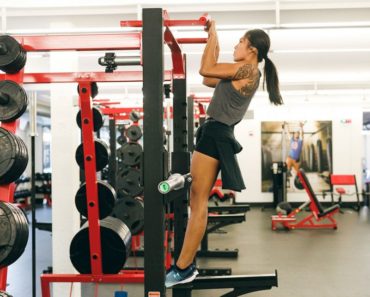
At Cressey Sports Performance, we specialize in taking care of the shoulders of professional baseball players. This is no easy task considering they put their shoulders through the most violent motion in all of sports when they throw.
But even the average gym-goer needs a carefully crafted shoulder routine, especially if the desire is to build strong shoulders and improve posture. Here are 5 exercises that will help you do just that:
1. Half-Kneeling 1-Arm Dumbbell Press
Pressing weight overhead is a fundamental strength movement and the quickest way to add muscle mass to your shoulders because it targets all of the shoulder muscles. However, overhead pressing can cause pain for many people who lack adequate shoulder mobility.
Luckily, pressing with 1 arm at a time from a half-kneeling position can ease much of the discomfort associated with heavy overhead pressing.
- Assume a half-kneeling stance with 1 foot in front of the other. Your hips and knees should both be bent at 90 degrees.
- Hold a dumbbell in 1 hand on the same side as the leg that’s behind you.
- With your glutes squeezed and core braced, use both hands to lift the dumbbell to the front of the pressing shoulder, keeping your elbow tucked in tight to your side.
- With your pinkie facing away from you, press the dumbbell straight overhead until your arm is straight. Lower back down slowly and repeat, making sure not to arch your lower back or push your head forward.
- Repeat on the opposite side.
This exercise can be done with heavy weights for lower reps (as few as 5 per side) or lighter weights for higher reps (10 or more). Try to use the same weight on each side if possible. If you can’t, don’t worry—use different weights on each side. Your lagging side should catch up after a few weeks.
2. Push-Up with Hand Switches
Push-ups get credit for building the chest and triceps, but they actually teach fantastic scapulohumeral rhythm, which means they teach the shoulder blade (scapula) and upper arm (humerus) to move together for optimal shoulder health.
And while push-ups build strength, adding in a hand switch increases the stability demands of the exercise for shoulders that will stand up to just about anything.
- Support yourself on your hands and toes, with your hands directly under your shoulders, in a straight line from head to toe.
- Squeeze your glutes, brace your core and place your hands onto the floor (right hand clockwise, left hand counterclockwise) to create full-body stability. Don’t lose this position throughout the exercise.
- Descend toward the floor by making a double chin with your neck and pulling yourself down with your elbows out at a 45-degree angle. Don’t poke your head forward or flare your elbows too much. Both of these mistakes will cause your shoulders to roll forward into a dangerous position.
- Once your chest hits the floor, push yourself away from the floor until you return to the starting position. Imagine pushing through your armpits to utilize your serratus anterior, an often-neglected muscle that helps the shoulder blades glide smoothly along the rib cage.
- Walk your hands over a small box or weight plate, and do another push-up. Make sure to keep your glutes and abs tight so your hips don’t wiggle from side to side.
- Do another push-up, and walk your hands back to the start.
If you’re not ready to do push-ups on the floor, elevate your hands on a bench or barbell rack to reduce the range of motion. Try to complete 2 sets of 4–5 reps per side.
3. 1-Arm Bottoms-Up Kettlebell Carry
A strong rotator cuff is essential for strong and healthy shoulders. A group of 4 muscles that hold the “ball” of the shoulder in the socket, the rotator cuff is easily injured, especially in throwing athletes or people who sit with slouched shoulders.
When people think of rotator cuff exercises, they think of boring rubber band rotations for hundreds of reps. But training your cuff doesn’t have to be lame. The 1-arm bottoms-up kettlebell carry challenges shoulder stability while doubling as a killer core exercise.
- Grab a kettlebell by the handle, and use both hands to lift it to shoulder height.
- Once your working arm is bent at 90 degrees with the bottom of the kettlebell facing the ceiling, let go with the nonworking hand.
- Brace your core, squeeze your glutes and make a double chin to stabilize your entire body.
- Walk as quickly as you can without losing position for distance (start with 20 yards and gradually work up to 40 yards). Make sure you feel the back of your shoulder doing the work, not the front of your shoulder or upper arm.
- Switch hands, and repeat.
If you don’t have a kettlebell, you can use a dumbbell, too, but you won’t get the instability factor. As you get stronger, try this same exercise with your arm straight overhead.
4. Prone Trap Raise
Lateral raises are a common exercise for building the medial deltoid (middle of the shoulder), but many people have pain or discomfort when raising weights out to the side. Luckily, prone trap raises help with posterior tilt of the shoulder blade, an essential function that can ease shoulder discomfort when lifting the arms.
There are several variations of the prone trap raise, but using the variation of an adjustable bench (see video below) works well for most people.
- Set up an adjustable bench at the lowest possible incline (about 15 degrees).
- Lie face down with your chin off the edge of the bench and toes dug into the floor.
- Make a double chin, brace your abs and squeeze your glutes to keep your spine in a neutral position.
- With your palms facing each other and arms directly under your shoulders, squeeze your shoulder blades together to lift your armpits off the bench. Make sure not to shrug or pull your arms down and back with your lats.
- With your thumbs up, lift your arms up in a Y shape until they’re even with your torso. You should feel this only in the back of your shoulder blades, not in the front of your shoulder.
- Return to the starting position, and repeat.
Use 3 sets of 8–10 reps per workout to build good technique. Once you’ve mastered the movement, hold light dumbbells in your hands (5–10 pounds).
5. Side-Lying External Rotation
They’re not flashy, but direct rotator cuff exercises are a must-do for healthy shoulders. The side-lying external rotation can be done just about anywhere with minimal equipment.
- Lie on your side with a half foam roller under the armpit of your working arm. If you don’t have a foam roller, use a rolled-up towel or sweatshirt.
- Support your head with your bottom arm, and pull your knees up toward your chest to prevent your lower back from arching.
- Hold a light weight in your top hand (start with 1–2 pounds), and slowly rotate your hand up toward the ceiling without moving your elbow or front of your shoulder. Only go as far as your mobility allows. Feel this only in the back of your shoulder, not the front or your biceps.
- Slowly lower down to the starting position, and repeat.
Do 3 sets of 10 reps per side at the end of your workout. Remember, the rotator cuff should never be trained to exhaustion, so always err on the side of lighter weights.
Brush Your Shoulders Off
Even if you don’t throw a baseball for a living, building a set of strong and healthy shoulders should be at the top of your to-do list at the gym. Try these exercises for the perfect blend of strength, mobility and longevity.
(via MyFitnessPal Blog)




